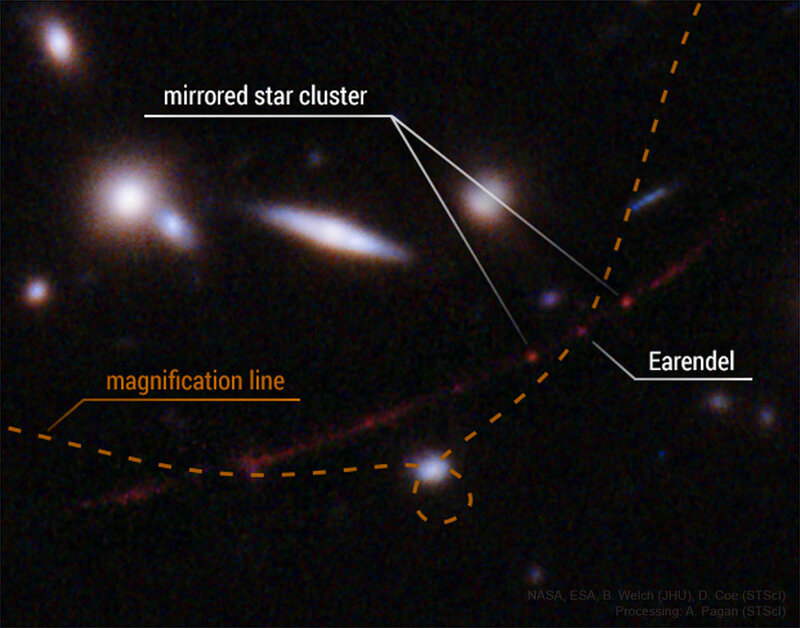Posted on Apr 6, 2022
APOD: 2022 April 6 - Earendel: A Star in the Early Universe
627
14
2
6
6
0
Edited 2 y ago
Posted 2 y ago
Responses: 1
Thank you my space-exploration advocate friend Maj William W. 'Bill' Price for posting the April 6th Astronomy Picture of the Day (APOD) Earendel: A Star in the Early Universe
Image: Earendel: A Star in the Early Universe
APOD Explanation: Is Earendel the farthest star yet discovered? This scientific possibility started when the Hubble Space Telescope observed a huge cluster of galaxies. The gravitational lens effect of this cluster was seen to magnify and distort a galaxy far in the background. This distorted background galaxy -- so far away it has a redshift of 6.2 -- appears in the featured image as a long red string, while beads on that string are likely to be star clusters. The galaxy cluster lens creates a line of maximum magnification line where superposed background objects may appear magnified many thousands of times. On the intersection between the galaxy line and the maximum magnification line is one "bead" which shows evidence of originating from a single bright star in the early universe -- now named Earendel. Future investigations may include more imaging by Hubble to see how Earendel's brightness varies, and, quite possibly, by the new James Webb Space Telescope when it becomes operational later this year. Earendel's great distance exceeds that of any known stable star -- although the star that exploded creating GRB 090423 had a redshift of 8.2.
Song of Eärendil performed by Adele McAllister © Tolkien Estate
https://www.youtube.com/watch?v=qRUYHJbWQs8
FYI SMSgt Lawrence McCarter Maj Bill Smith, Ph.D. PO1 William "Chip" Nagel CPT (Join to see) SPC Nancy Greene CPL Douglas Chrysler PO3 Edward Riddle SGT Mary G. SGT Tiffanie G. MSgt Gloria Vance SSG Michael Noll SPC Michael Duricko, Ph.D CSM Charles Hayden GySgt Jack Wallace1SG Dan Capri CSM Bob Stanek SGM Bill Frazer SGM Major Stroupe SGT Mark Anderson
Image: Earendel: A Star in the Early Universe
APOD Explanation: Is Earendel the farthest star yet discovered? This scientific possibility started when the Hubble Space Telescope observed a huge cluster of galaxies. The gravitational lens effect of this cluster was seen to magnify and distort a galaxy far in the background. This distorted background galaxy -- so far away it has a redshift of 6.2 -- appears in the featured image as a long red string, while beads on that string are likely to be star clusters. The galaxy cluster lens creates a line of maximum magnification line where superposed background objects may appear magnified many thousands of times. On the intersection between the galaxy line and the maximum magnification line is one "bead" which shows evidence of originating from a single bright star in the early universe -- now named Earendel. Future investigations may include more imaging by Hubble to see how Earendel's brightness varies, and, quite possibly, by the new James Webb Space Telescope when it becomes operational later this year. Earendel's great distance exceeds that of any known stable star -- although the star that exploded creating GRB 090423 had a redshift of 8.2.
Song of Eärendil performed by Adele McAllister © Tolkien Estate
https://www.youtube.com/watch?v=qRUYHJbWQs8
FYI SMSgt Lawrence McCarter Maj Bill Smith, Ph.D. PO1 William "Chip" Nagel CPT (Join to see) SPC Nancy Greene CPL Douglas Chrysler PO3 Edward Riddle SGT Mary G. SGT Tiffanie G. MSgt Gloria Vance SSG Michael Noll SPC Michael Duricko, Ph.D CSM Charles Hayden GySgt Jack Wallace1SG Dan Capri CSM Bob Stanek SGM Bill Frazer SGM Major Stroupe SGT Mark Anderson
(6)
(0)
LTC Stephen F.
Gina Jeffreys - Distant Star ·
https://www.youtube.com/watch?v=GhCyyMw7gpY
FYI Sgt (Join to see) SFC Joe S. Davis Jr., MSM, DSL Lt Col Charlie Brown Lt Col John (Jack) Christensen MSG Greg Kelly Maj Bill Smith, Ph.D. MAJ Dale E. Wilson, Ph.D. CPL Douglas Chrysler Sgt Albert Castro PO3 Lynn Spalding SFC (Join to see) SGT David A. 'Cowboy' Groth CPT Gurinder (Gene) Rana SSG William Jones SGT Steve McFarland SGT (Join to see) Sgt Jim Belanus PO3 (Join to see) PO3 Steven Sherrill Cpl Vic Burk
https://www.youtube.com/watch?v=GhCyyMw7gpY
FYI Sgt (Join to see) SFC Joe S. Davis Jr., MSM, DSL Lt Col Charlie Brown Lt Col John (Jack) Christensen MSG Greg Kelly Maj Bill Smith, Ph.D. MAJ Dale E. Wilson, Ph.D. CPL Douglas Chrysler Sgt Albert Castro PO3 Lynn Spalding SFC (Join to see) SGT David A. 'Cowboy' Groth CPT Gurinder (Gene) Rana SSG William Jones SGT Steve McFarland SGT (Join to see) Sgt Jim Belanus PO3 (Join to see) PO3 Steven Sherrill Cpl Vic Burk
(2)
(0)
Read This Next



 NASA
NASA Space
Space Science
Science Photography
Photography Astronomy
Astronomy





